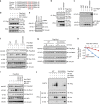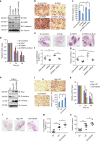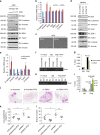SCFFBW7-mediated degradation of Brg1 suppresses gastric cancer metastasis
- PMID: 30177679
- PMCID: PMC6120942
- DOI: 10.1038/s41467-018-06038-y
SCFFBW7-mediated degradation of Brg1 suppresses gastric cancer metastasis
Abstract
Brg1/SMARCA4 serves as the ATPase and the helicase catalytic subunit for the multi-component SWI/SNF chromatin remodeling complex, which plays a pivotal role in governing chromatin structure and gene transcription. However, the upstream signaling pathways regulating Brg1 protein stability and its physiological contribution to carcinogenesis remain largely elusive. Here we report that Brg1 is a bona fide ubiquitin substrate of SCFFBW7. We reveal that CK1δ phosphorylates Brg1 at Ser31/Ser35 residues to facilitate the binding of Brg1 to FBW7, leading to ubiquitination-mediated degradation. In keeping with a tumor suppressive role of FBW7 in human gastric cancer, we find an inverse correlation between FBW7 and Brg1 expression in human gastric cancer clinical samples. Mechanistically, we find that stabilization of Brg1 in gastric cancer cells suppresses E-cadherin expression, subsequently promoting gastric cancer metastasis. Hence, this previously unknown FBW7/Brg1 signaling axis provides the molecular basis and the rationale to target Brg1 in FBW7-compromised human gastric cancers.
Conflict of interest statement
The authors declare no competing interests.
Figures






References
-
- Reisman DN, Sciarrotta J, Wang W, Funkhouser WK, Weissman BE. Loss of BRG1/BRM in human lung cancer cell lines and primary lung cancers: correlation with poor prognosis. Cancer Res. 2003;63:560–566. - PubMed
Publication types
MeSH terms
Substances
Grants and funding
- 81402317/National Natural Science Foundation of China (National Science Foundation of China)/International
- R01 CA200651/CA/NCI NIH HHS/United States
- R01 CA200573/CA/NCI NIH HHS/United States
- R01 CA177910/CA/NCI NIH HHS/United States
- CA229307/U.S. Department of Health & Human Services | NIH | National Cancer Institute (NCI)/International
LinkOut - more resources
Full Text Sources
Other Literature Sources
Medical
Molecular Biology Databases
Research Materials
Miscellaneous

